The 6.0L diesel engine in '03 to '07 Ford Super Duty trucks has a reputation for needing repairs. While two competitors at Diesel Power Challenge 2015 proved it can be turned into a true performance powerhouse, civilians living with stock 6.0L-motivated daily drivers are often left frustrated. Our friend Dave Rifkin is no stranger to the dealership waiting room. He's already returned two Super Duty trucks (one gasoline- and one diesel-powered) using Lemon Law regulations before he moved on to this '04 F-350 with the 6.0L Power Stroke.
It hasn't exactly been trouble-free, either. At 10,000 miles, a plastic factory intercooler pipe burst, leaving Dave stranded; it was replaced under warranty with aluminum tubing and better clamps. Then, at 145,000 miles, the EGR cooler went bad and had to be replaced. Just 10,000 miles after that, he started to experience poor low-end performance and got a Check Engine light that couldn't be cleared to pass a smog test. Bummer! Fortunately for Dave, his friend Rick Head has lots of experience with turbochargers and suspected stuck variable vanes in the turbine were to blame. He was right, and here's how he got Dave back on the road with a truck that, "performs just like it did when I bought it new."
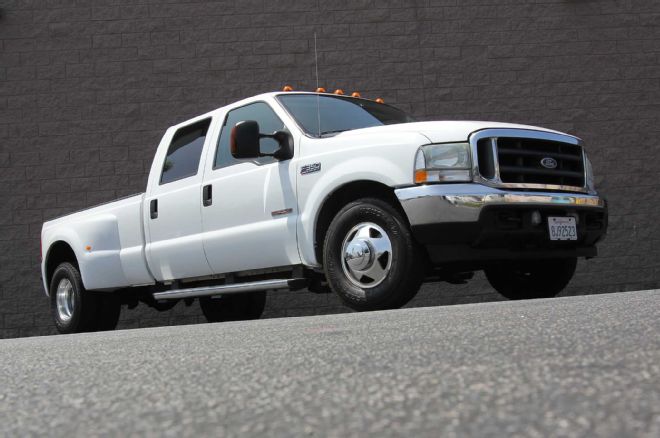
| 2004 Ford F 350 Diesel Front Side View
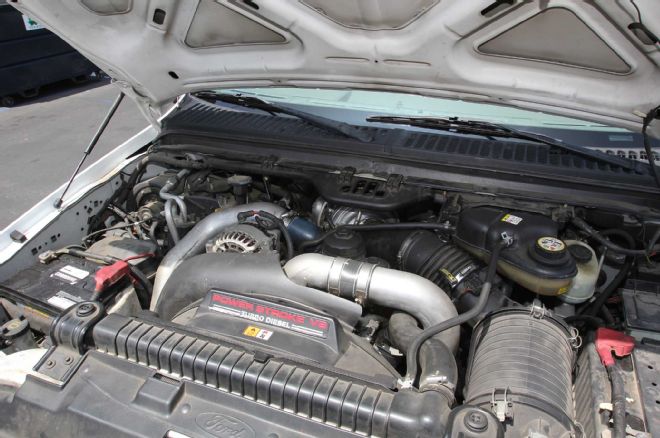
| 2004 Ford F 350 Diesel 6.0L Engine
This '04 Ford F-350 owned by Dave Rifkin has not exactly been trouble-free, having suffered through a burst intercooler pipe, a worn-out EGR cooler, and a turbo that became gunked up to the point that he lost all low-end performance and couldn't pass a smog test.
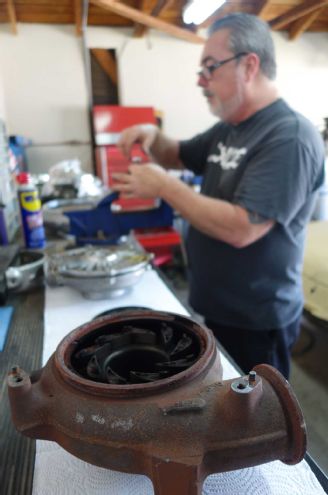
| 2004 Ford F 350 Diesel Turbo Removed
After removing the turbocharger from the engine, Rick Head is able to separate the compressor side (intake) and the turbine side (exhaust) from the centersection.
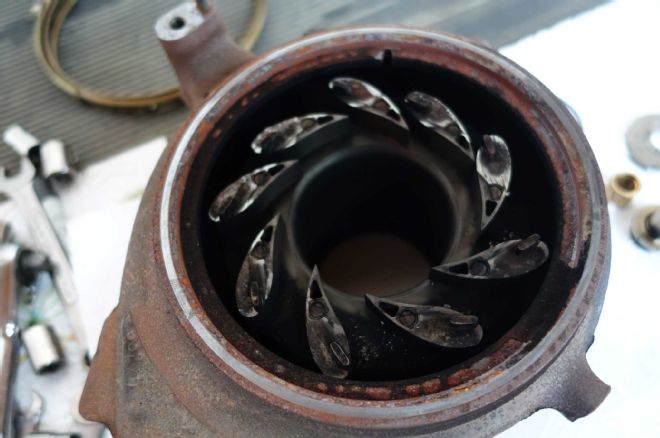
| 2004 Ford F 350 Diesel Turbo Vanes Stuck
One look into the turbine housing and Rick is able to confirm his suspicion that carbon deposits have built up to the point that the vanes are stuck in the open position. This makes the truck act like it has a large fixed turbo (instead of a variable geometry unit), because the vanes cannot move to constrict the limited exhaust flow produced during low-rpm and low-load driving.
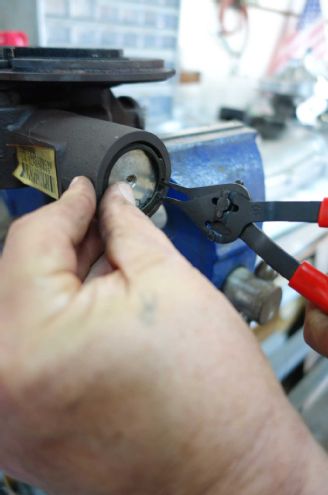
| 2004 Ford F 350 Diesel Turbo VGT Actuator Piston Removal
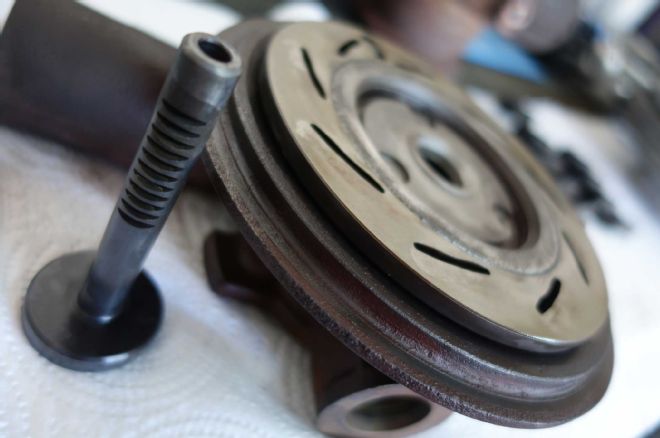
| 2004 Ford F 350 Diesel Turbo Actuator Piston
Rick removes the actuator piston that controls the drive plate (unison ring), which turns all the vanes inside the exhaust side of the turbo at the same time.
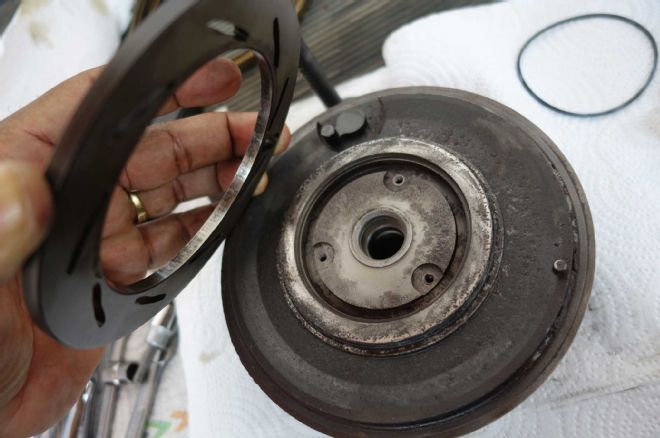
| 2004 Ford F 350 Diesel Turbo Variable Vanes Unison Ring
The unison ring and its mounting area had excessive carbon deposits that were preventing parts from moving freely.
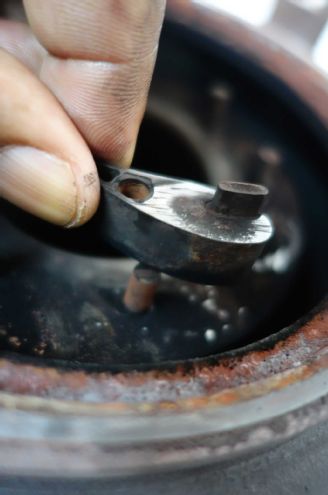
| 2004 Ford F 350 Diesel Turbo Vane Removal
Rick removes the vanes from the turbine housing and sets them aside. Keeping track of their placement isn't necessary because they're all identical.
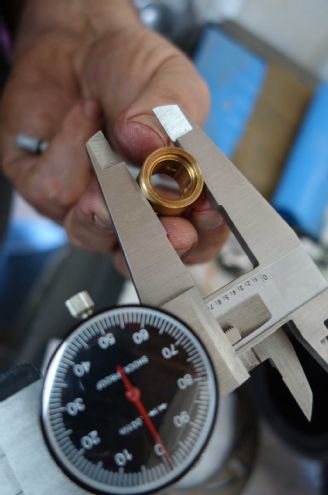
| 2004 Ford F 350 Diesel Turbo Center Section Journal Bearings Meaurement
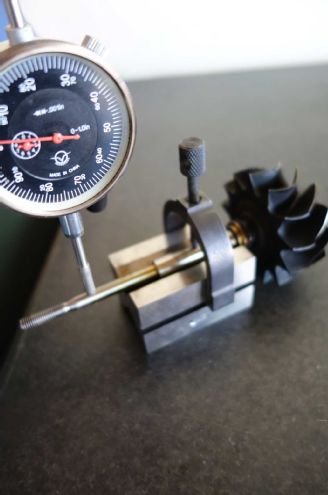
| 2004 Ford F 350 Diesel Turbo Shaft Measurement
The thrust bearings, radial bearings, journals, shaft, and other parts are closely inspected. Rick says, "I measure everything, because even though a turbo is a simple device, if things are out of spec, it will reduce itself to 'kit form.'" He says it's not unusual for all of these parts to be reused on a 6.0L Power Stroke, but there's no reason to take chances.
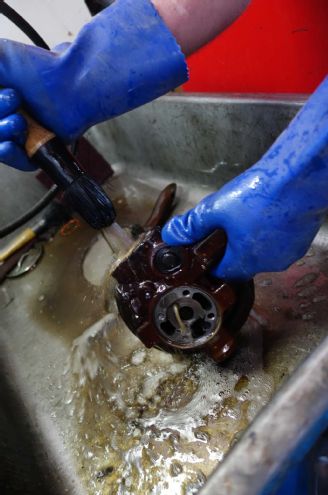
| 2004 Ford F 350 Diesel Turbo Solvent Bath Cleaning
With the parts inspected and verified as being good, everything is cleaned in a solvent bath washer to remove all oil residue and grease. Rick emphasizes you should make sure all parts are within specifications before you move on to cleaning because bad parts are a waste of time, and compromising on tolerances is not an option since variable-geometry turbochargers cycle and spin so quickly.
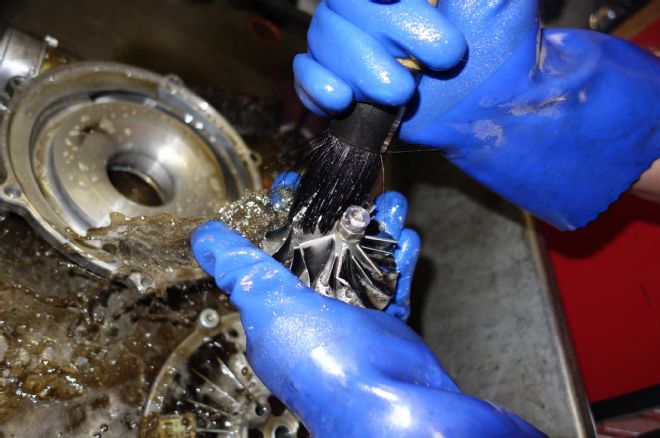
| 2004 Ford F 350 Diesel Turbo Compressor Wheel Solvent Bath Wash
After cleaning, Rick inspects the compressor wheel for cracks or nicks on the fins that could be evidence of something striking the wheel and causing damage. This wheel has no signs of harm, so it can be reused.
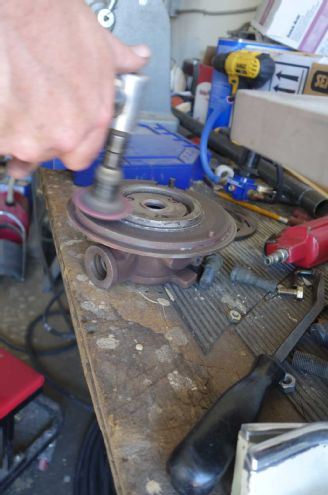
| 2004 Ford F 350 Diesel Turbo Unison Drive Plate Seat Repair
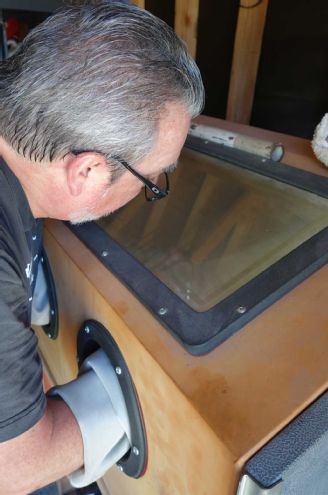
| 2004 Ford F 350 Diesel Turbo Turbine Housing Vane Post Repair
A cartridge roll is used to remove any nicks, burrs, or imperfections inside the turbine housing and on the vane mounting posts.
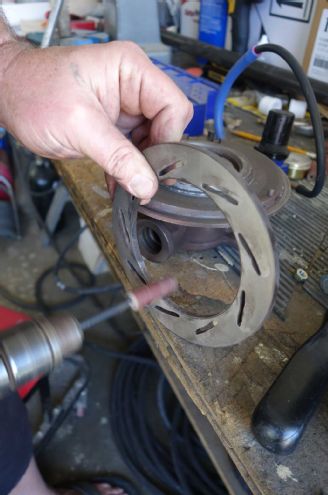
| 2004 Ford F 350 Diesel Turbo Unison Drive Plate Repair
It's also used to clean up the drive plate and remove any out-of-round edges that can be created by the extreme thermal cycling experienced by the turbocharger.

| 2004 Ford F 350 Diesel Turbo Repair Glass Media Blast
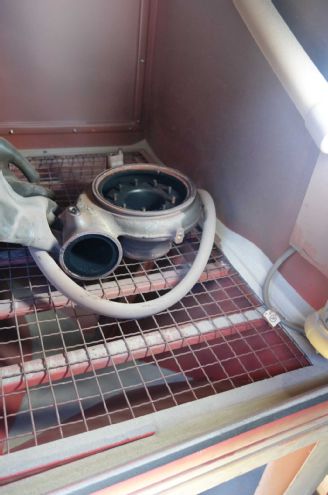
| 2004 Ford F 350 Diesel Turbo Repair After Glass Media Blast
Rick uses a media blaster cabinet loaded with glass beads to remove the carbon deposits inside the turbine housing, on the drive plate, and on the vanes. He says glass works best because it leaves a clean and smooth surface, unlike sand.
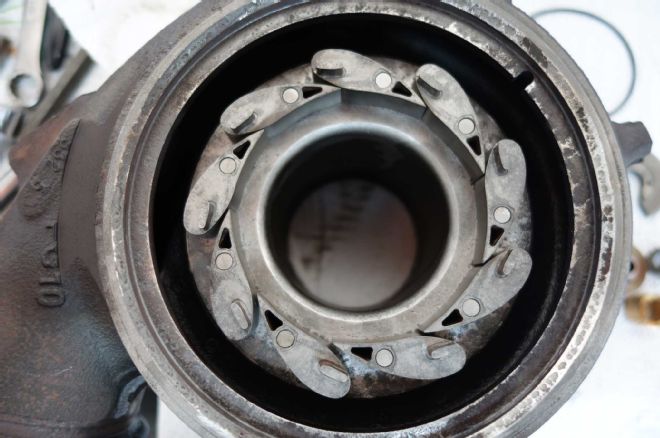
| 2004 Ford F 350 Diesel Turbine Vanes After Media Blast
With everything nice and clean, the vanes can be installed and set aside until the turbocharger is reassembled.
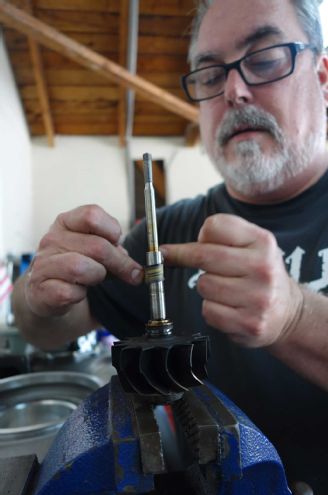
| 2004 Ford F 350 Diesel Turbo Shaft Journal 1200 Grit Polishing Band
Rick puts the shaft into a vise (the compressor wheel was removed during the turbo disassembly) and uses WD-40 and a 1,200-grit fine polishing band to smooth out the journals where the bearings ride. There was very little wear evident, so this step made the shaft look new again.
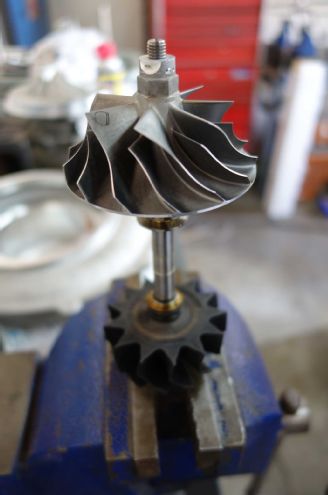
| 2004 Ford F 350 Diesel Turbo Compressor Wheel Installation Index Mark
To install the compressor wheel on the shaft, Rick's preferred method is to spin it down to the last thread, then turn it just 30 to 45 degrees more: "Whatever feels right." This avoids excess pressure that can damage the wheel or pull and distort the shaft threads. Once it is in place, Rick uses a pen to make an index mark on the wheel and shaft (arrows) so they can be matched up during the reassembly.
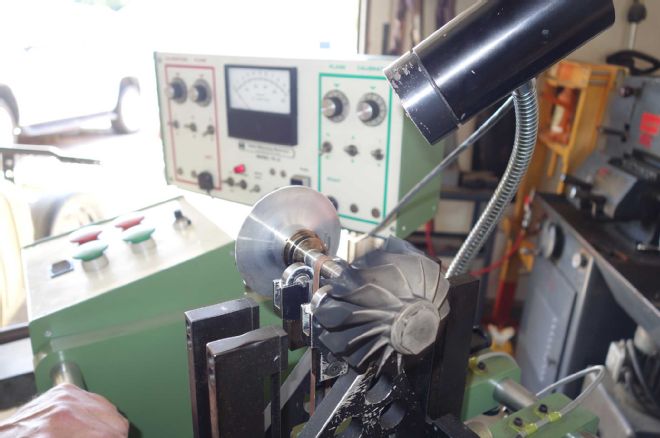
| 2004 Ford F 350 Diesel Turbo Shaft Hines Balancing Machine
With the compressor wheel temporarily back in place, Rick puts the entire shaft assembly onto a Hines two-plane turbocharger balance machine. The tests performed will reveal if the shaft is not completely straight or if it needs to be repaired or replaced.
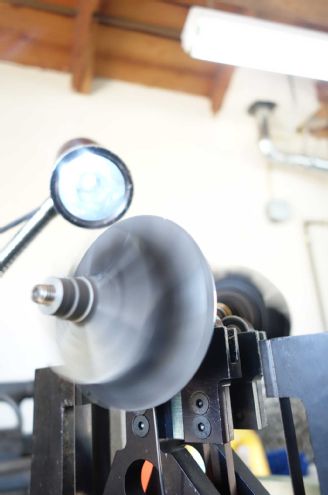
| 2004 Ford F 350 Diesel Turbo Hines Balancing Machine Strobe Light
A piece of wax is placed on the compressor wheel, adding artificial weight to dial in the machine. The speed is increased until it matches the rotor group weight determined for this particular turbo, and a strobe light illuminates when the heaviest part of the assembly is at the 12-o'clock position. The step is repeated with the wax removed, and since the strobe lights the same section where the wax was, Rick knows this shaft is still within factory tolerances and won't even need any sanding to correct an unbalance. He says it's not uncommon for the shafts on 6.0L turbos to be within spec even after more than 150,000 miles of use.
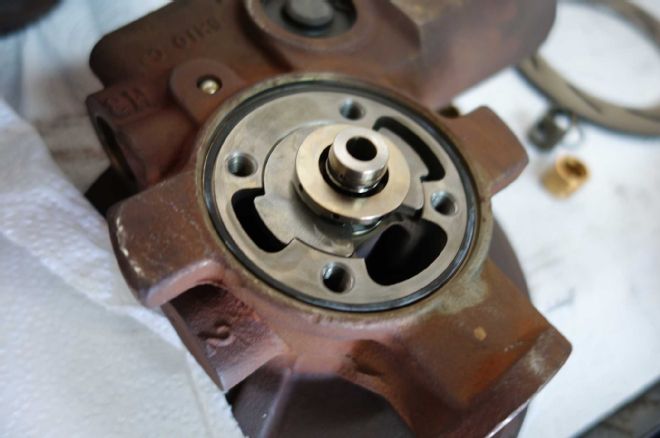
| 2004 Ford F 350 Diesel Turbo Center Section Bearings Installation
After all the cleaning and confirmation that all parts are good to go, Rick oils and replaces the bearings and other cartridge parts inside the centersection of the turbocharger.
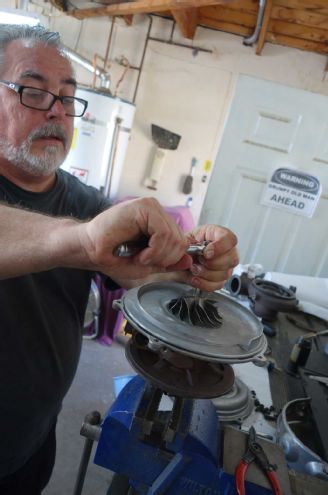
| 2004 Ford F 350 Diesel Turbo Compressor Wheel Installaton
Next, he places the shaft assembly into the centersection and uses a vise to secure the turbine and shaft while he pulls the compressor wheel until the index lines match up.
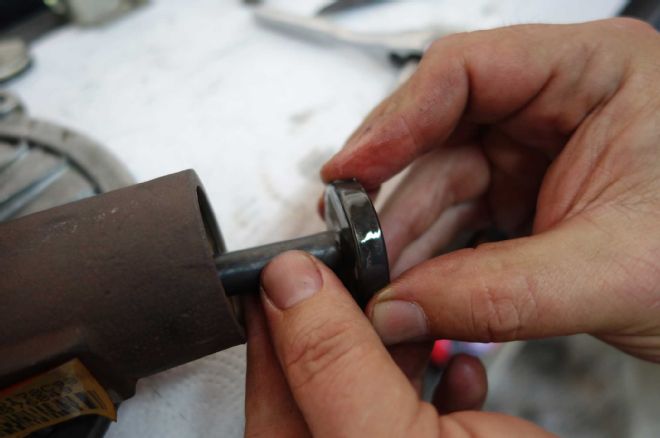
| 2004 Ford F 350 Diesel Turbo Actuator Piston Installation
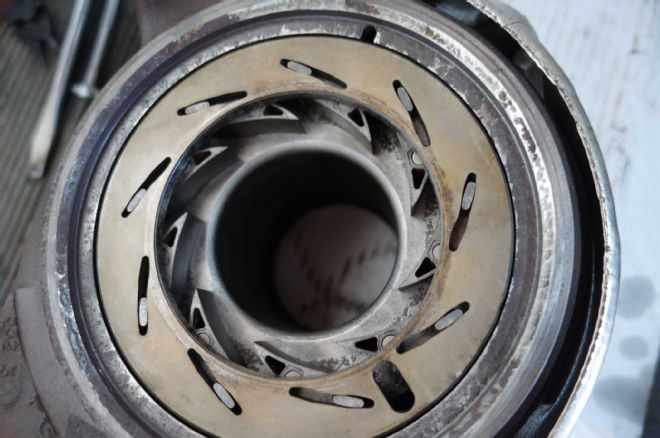
| 2004 Ford F 350 Diesel Turbo Unison Drive Plate After Media Blast
During installation, the actuator piston is timed with the lever that moves the unison ring, which turns the variable vanes.
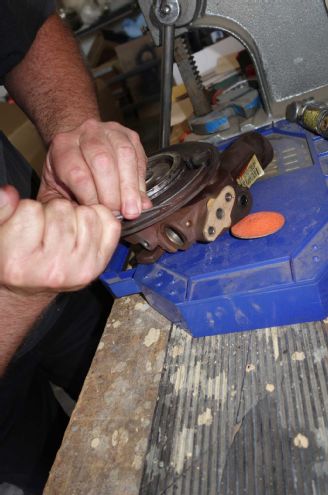
| 2004 Ford F 350 Diesel Turbo Seal Cleaning Process
Before the turbine housing is mounted back on the centersection, Rick uses an awl to remove any debris that could prevent a solid seal and cause an exhaust leak.
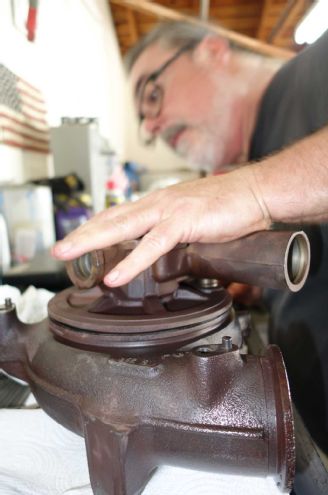
| 2004 Ford F 350 Diesel Turbo Turbine Assembly
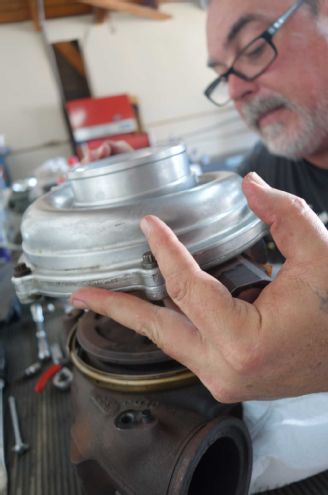
| 2004 Ford F 350 Diesel Turbo Compressor Assembly
With both sides of the turbocharger assembled, Rick attaches the compressor and turbine sections while making sure the index pin and the drive plate lever line up with the drive plate housing and the unison plate.
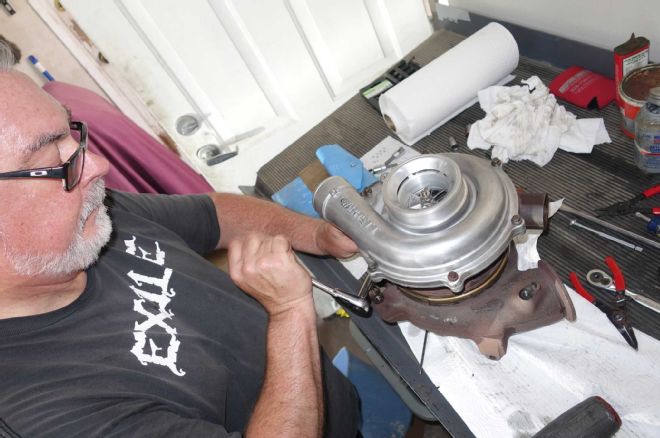
| 2004 Ford F 350 Diesel Turbo Turbo Reassembly
Once everything is confirmed to be in its rightful place, Rick is ready to tighten up the turbo assembly and replace the heat shield on the turbine and the end cap and its retainer for the VGT actuator. With the turbo reinstalled on the engine, owner Dave Rifkin says his F-350's performance is back to normal and that the truck feels just like it did the day he brought it home from the dealership. Plus, that pesky Check Engine light is gone and the rig easily passes a smog test, which means he'll have peace of mind for the next two years.
 | 2004 Ford F 350 Diesel Front Side View
| 2004 Ford F 350 Diesel Front Side View
 | 2004 Ford F 350 Diesel 6.0L Engine
This '04 Ford F-350 owned by Dave Rifkin has not exactly been trouble-free, having suffered through a burst intercooler pipe, a worn-out EGR cooler, and a turbo that became gunked up to the point that he lost all low-end performance and couldn't pass a smog test.
| 2004 Ford F 350 Diesel 6.0L Engine
This '04 Ford F-350 owned by Dave Rifkin has not exactly been trouble-free, having suffered through a burst intercooler pipe, a worn-out EGR cooler, and a turbo that became gunked up to the point that he lost all low-end performance and couldn't pass a smog test.
 | 2004 Ford F 350 Diesel Turbo Removed
After removing the turbocharger from the engine, Rick Head is able to separate the compressor side (intake) and the turbine side (exhaust) from the centersection.
| 2004 Ford F 350 Diesel Turbo Removed
After removing the turbocharger from the engine, Rick Head is able to separate the compressor side (intake) and the turbine side (exhaust) from the centersection.
 | 2004 Ford F 350 Diesel Turbo Vanes Stuck
One look into the turbine housing and Rick is able to confirm his suspicion that carbon deposits have built up to the point that the vanes are stuck in the open position. This makes the truck act like it has a large fixed turbo (instead of a variable geometry unit), because the vanes cannot move to constrict the limited exhaust flow produced during low-rpm and low-load driving.
| 2004 Ford F 350 Diesel Turbo Vanes Stuck
One look into the turbine housing and Rick is able to confirm his suspicion that carbon deposits have built up to the point that the vanes are stuck in the open position. This makes the truck act like it has a large fixed turbo (instead of a variable geometry unit), because the vanes cannot move to constrict the limited exhaust flow produced during low-rpm and low-load driving.
 | 2004 Ford F 350 Diesel Turbo VGT Actuator Piston Removal
| 2004 Ford F 350 Diesel Turbo VGT Actuator Piston Removal
 | 2004 Ford F 350 Diesel Turbo Actuator Piston
Rick removes the actuator piston that controls the drive plate (unison ring), which turns all the vanes inside the exhaust side of the turbo at the same time.
| 2004 Ford F 350 Diesel Turbo Actuator Piston
Rick removes the actuator piston that controls the drive plate (unison ring), which turns all the vanes inside the exhaust side of the turbo at the same time.
 | 2004 Ford F 350 Diesel Turbo Variable Vanes Unison Ring
The unison ring and its mounting area had excessive carbon deposits that were preventing parts from moving freely.
| 2004 Ford F 350 Diesel Turbo Variable Vanes Unison Ring
The unison ring and its mounting area had excessive carbon deposits that were preventing parts from moving freely.
 | 2004 Ford F 350 Diesel Turbo Vane Removal
Rick removes the vanes from the turbine housing and sets them aside. Keeping track of their placement isn't necessary because they're all identical.
| 2004 Ford F 350 Diesel Turbo Vane Removal
Rick removes the vanes from the turbine housing and sets them aside. Keeping track of their placement isn't necessary because they're all identical.
 | 2004 Ford F 350 Diesel Turbo Center Section Journal Bearings Meaurement
| 2004 Ford F 350 Diesel Turbo Center Section Journal Bearings Meaurement
 | 2004 Ford F 350 Diesel Turbo Shaft Measurement
The thrust bearings, radial bearings, journals, shaft, and other parts are closely inspected. Rick says, "I measure everything, because even though a turbo is a simple device, if things are out of spec, it will reduce itself to 'kit form.'" He says it's not unusual for all of these parts to be reused on a 6.0L Power Stroke, but there's no reason to take chances.
| 2004 Ford F 350 Diesel Turbo Shaft Measurement
The thrust bearings, radial bearings, journals, shaft, and other parts are closely inspected. Rick says, "I measure everything, because even though a turbo is a simple device, if things are out of spec, it will reduce itself to 'kit form.'" He says it's not unusual for all of these parts to be reused on a 6.0L Power Stroke, but there's no reason to take chances.
 | 2004 Ford F 350 Diesel Turbo Solvent Bath Cleaning
With the parts inspected and verified as being good, everything is cleaned in a solvent bath washer to remove all oil residue and grease. Rick emphasizes you should make sure all parts are within specifications before you move on to cleaning because bad parts are a waste of time, and compromising on tolerances is not an option since variable-geometry turbochargers cycle and spin so quickly.
| 2004 Ford F 350 Diesel Turbo Solvent Bath Cleaning
With the parts inspected and verified as being good, everything is cleaned in a solvent bath washer to remove all oil residue and grease. Rick emphasizes you should make sure all parts are within specifications before you move on to cleaning because bad parts are a waste of time, and compromising on tolerances is not an option since variable-geometry turbochargers cycle and spin so quickly.
 | 2004 Ford F 350 Diesel Turbo Compressor Wheel Solvent Bath Wash
After cleaning, Rick inspects the compressor wheel for cracks or nicks on the fins that could be evidence of something striking the wheel and causing damage. This wheel has no signs of harm, so it can be reused.
| 2004 Ford F 350 Diesel Turbo Compressor Wheel Solvent Bath Wash
After cleaning, Rick inspects the compressor wheel for cracks or nicks on the fins that could be evidence of something striking the wheel and causing damage. This wheel has no signs of harm, so it can be reused.
 | 2004 Ford F 350 Diesel Turbo Unison Drive Plate Seat Repair
| 2004 Ford F 350 Diesel Turbo Unison Drive Plate Seat Repair
 | 2004 Ford F 350 Diesel Turbo Turbine Housing Vane Post Repair
A cartridge roll is used to remove any nicks, burrs, or imperfections inside the turbine housing and on the vane mounting posts.
| 2004 Ford F 350 Diesel Turbo Turbine Housing Vane Post Repair
A cartridge roll is used to remove any nicks, burrs, or imperfections inside the turbine housing and on the vane mounting posts.
 | 2004 Ford F 350 Diesel Turbo Unison Drive Plate Repair
It's also used to clean up the drive plate and remove any out-of-round edges that can be created by the extreme thermal cycling experienced by the turbocharger.
| 2004 Ford F 350 Diesel Turbo Unison Drive Plate Repair
It's also used to clean up the drive plate and remove any out-of-round edges that can be created by the extreme thermal cycling experienced by the turbocharger.
 | 2004 Ford F 350 Diesel Turbo Repair Glass Media Blast
| 2004 Ford F 350 Diesel Turbo Repair Glass Media Blast
 | 2004 Ford F 350 Diesel Turbo Repair After Glass Media Blast
Rick uses a media blaster cabinet loaded with glass beads to remove the carbon deposits inside the turbine housing, on the drive plate, and on the vanes. He says glass works best because it leaves a clean and smooth surface, unlike sand.
| 2004 Ford F 350 Diesel Turbo Repair After Glass Media Blast
Rick uses a media blaster cabinet loaded with glass beads to remove the carbon deposits inside the turbine housing, on the drive plate, and on the vanes. He says glass works best because it leaves a clean and smooth surface, unlike sand.
 | 2004 Ford F 350 Diesel Turbine Vanes After Media Blast
With everything nice and clean, the vanes can be installed and set aside until the turbocharger is reassembled.
| 2004 Ford F 350 Diesel Turbine Vanes After Media Blast
With everything nice and clean, the vanes can be installed and set aside until the turbocharger is reassembled.
 | 2004 Ford F 350 Diesel Turbo Shaft Journal 1200 Grit Polishing Band
Rick puts the shaft into a vise (the compressor wheel was removed during the turbo disassembly) and uses WD-40 and a 1,200-grit fine polishing band to smooth out the journals where the bearings ride. There was very little wear evident, so this step made the shaft look new again.
| 2004 Ford F 350 Diesel Turbo Shaft Journal 1200 Grit Polishing Band
Rick puts the shaft into a vise (the compressor wheel was removed during the turbo disassembly) and uses WD-40 and a 1,200-grit fine polishing band to smooth out the journals where the bearings ride. There was very little wear evident, so this step made the shaft look new again.
 | 2004 Ford F 350 Diesel Turbo Compressor Wheel Installation Index Mark
To install the compressor wheel on the shaft, Rick's preferred method is to spin it down to the last thread, then turn it just 30 to 45 degrees more: "Whatever feels right." This avoids excess pressure that can damage the wheel or pull and distort the shaft threads. Once it is in place, Rick uses a pen to make an index mark on the wheel and shaft (arrows) so they can be matched up during the reassembly.
| 2004 Ford F 350 Diesel Turbo Compressor Wheel Installation Index Mark
To install the compressor wheel on the shaft, Rick's preferred method is to spin it down to the last thread, then turn it just 30 to 45 degrees more: "Whatever feels right." This avoids excess pressure that can damage the wheel or pull and distort the shaft threads. Once it is in place, Rick uses a pen to make an index mark on the wheel and shaft (arrows) so they can be matched up during the reassembly.
 | 2004 Ford F 350 Diesel Turbo Shaft Hines Balancing Machine
With the compressor wheel temporarily back in place, Rick puts the entire shaft assembly onto a Hines two-plane turbocharger balance machine. The tests performed will reveal if the shaft is not completely straight or if it needs to be repaired or replaced.
| 2004 Ford F 350 Diesel Turbo Shaft Hines Balancing Machine
With the compressor wheel temporarily back in place, Rick puts the entire shaft assembly onto a Hines two-plane turbocharger balance machine. The tests performed will reveal if the shaft is not completely straight or if it needs to be repaired or replaced.
 | 2004 Ford F 350 Diesel Turbo Hines Balancing Machine Strobe Light
A piece of wax is placed on the compressor wheel, adding artificial weight to dial in the machine. The speed is increased until it matches the rotor group weight determined for this particular turbo, and a strobe light illuminates when the heaviest part of the assembly is at the 12-o'clock position. The step is repeated with the wax removed, and since the strobe lights the same section where the wax was, Rick knows this shaft is still within factory tolerances and won't even need any sanding to correct an unbalance. He says it's not uncommon for the shafts on 6.0L turbos to be within spec even after more than 150,000 miles of use.
| 2004 Ford F 350 Diesel Turbo Hines Balancing Machine Strobe Light
A piece of wax is placed on the compressor wheel, adding artificial weight to dial in the machine. The speed is increased until it matches the rotor group weight determined for this particular turbo, and a strobe light illuminates when the heaviest part of the assembly is at the 12-o'clock position. The step is repeated with the wax removed, and since the strobe lights the same section where the wax was, Rick knows this shaft is still within factory tolerances and won't even need any sanding to correct an unbalance. He says it's not uncommon for the shafts on 6.0L turbos to be within spec even after more than 150,000 miles of use.
 | 2004 Ford F 350 Diesel Turbo Center Section Bearings Installation
After all the cleaning and confirmation that all parts are good to go, Rick oils and replaces the bearings and other cartridge parts inside the centersection of the turbocharger.
| 2004 Ford F 350 Diesel Turbo Center Section Bearings Installation
After all the cleaning and confirmation that all parts are good to go, Rick oils and replaces the bearings and other cartridge parts inside the centersection of the turbocharger.
 | 2004 Ford F 350 Diesel Turbo Compressor Wheel Installaton
Next, he places the shaft assembly into the centersection and uses a vise to secure the turbine and shaft while he pulls the compressor wheel until the index lines match up.
| 2004 Ford F 350 Diesel Turbo Compressor Wheel Installaton
Next, he places the shaft assembly into the centersection and uses a vise to secure the turbine and shaft while he pulls the compressor wheel until the index lines match up.
 | 2004 Ford F 350 Diesel Turbo Actuator Piston Installation
| 2004 Ford F 350 Diesel Turbo Actuator Piston Installation
 | 2004 Ford F 350 Diesel Turbo Unison Drive Plate After Media Blast
During installation, the actuator piston is timed with the lever that moves the unison ring, which turns the variable vanes.
| 2004 Ford F 350 Diesel Turbo Unison Drive Plate After Media Blast
During installation, the actuator piston is timed with the lever that moves the unison ring, which turns the variable vanes.
 | 2004 Ford F 350 Diesel Turbo Seal Cleaning Process
Before the turbine housing is mounted back on the centersection, Rick uses an awl to remove any debris that could prevent a solid seal and cause an exhaust leak.
| 2004 Ford F 350 Diesel Turbo Seal Cleaning Process
Before the turbine housing is mounted back on the centersection, Rick uses an awl to remove any debris that could prevent a solid seal and cause an exhaust leak.
 | 2004 Ford F 350 Diesel Turbo Turbine Assembly
| 2004 Ford F 350 Diesel Turbo Turbine Assembly
 | 2004 Ford F 350 Diesel Turbo Compressor Assembly
With both sides of the turbocharger assembled, Rick attaches the compressor and turbine sections while making sure the index pin and the drive plate lever line up with the drive plate housing and the unison plate.
| 2004 Ford F 350 Diesel Turbo Compressor Assembly
With both sides of the turbocharger assembled, Rick attaches the compressor and turbine sections while making sure the index pin and the drive plate lever line up with the drive plate housing and the unison plate.
 | 2004 Ford F 350 Diesel Turbo Turbo Reassembly
Once everything is confirmed to be in its rightful place, Rick is ready to tighten up the turbo assembly and replace the heat shield on the turbine and the end cap and its retainer for the VGT actuator. With the turbo reinstalled on the engine, owner Dave Rifkin says his F-350's performance is back to normal and that the truck feels just like it did the day he brought it home from the dealership. Plus, that pesky Check Engine light is gone and the rig easily passes a smog test, which means he'll have peace of mind for the next two years.
| 2004 Ford F 350 Diesel Turbo Turbo Reassembly
Once everything is confirmed to be in its rightful place, Rick is ready to tighten up the turbo assembly and replace the heat shield on the turbine and the end cap and its retainer for the VGT actuator. With the turbo reinstalled on the engine, owner Dave Rifkin says his F-350's performance is back to normal and that the truck feels just like it did the day he brought it home from the dealership. Plus, that pesky Check Engine light is gone and the rig easily passes a smog test, which means he'll have peace of mind for the next two years.